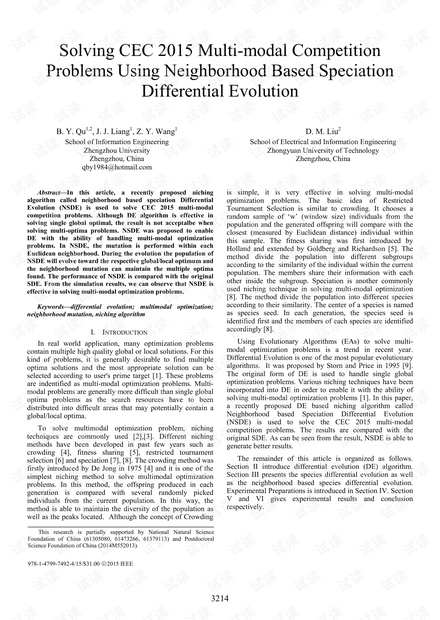
Solving CEC 2015 Multi-modal Competition
Problems Using Neighborhood Based Speciation
Differential Evolution
B. Y. Qu
1,2
, J. J. Liang
1
, Z. Y. Wang
1
School of Information Engineering
Zhengzhou University
Zhengzhou, China
qby1984@hotmail.com
D. M. Liu
2
School of Electrical and Information Engineering
Zhongyuan University of Technology
Zhengzhou, China
Abstract—In this article, a recently proposed niching
algorithm called neighborhood based speciation Differential
Evolution (NSDE) is used to solve CEC 2015 multi-modal
competition problems. Although DE algorithm is effective in
solving single global optimal, the result is not acceptalbe when
solving multi-optima problems. NSDE was proposed to enable
DE with the ability of handling multi-modal optimization
problems. In NSDE, the mutation is performed within each
Euclidean neighborhood. During the evolution the population of
NSDE will evolve toward the respective global/local optimum and
the neighborhood mutation can maintain the multiple optima
found. The performance of NSDE is compared with the original
SDE. From the simulation results, we can observe that NSDE is
effective in solving multi-modal optimization problems.
Keywords—differential evolution; multimodal optimization;
neighborhood mutation, niching algorithm
I. INTRODUCTION
In real world application, many optimization problems
contain multiple high quality global or local solutions. For this
kind of problems, it is generally desirable to find multiple
optima solutions and the most appropriate solution can be
selected according to user's prime target [1]. These problems
are indentified as multi-modal optimization problems. Multi-
modal problems are generally more difficult than single global
optima problems as the search resources have to been
distributed into difficult areas that may potentially contain a
global/local optima.
To solve multimodal optimization problem, niching
techniques are commonly used [2],[3]. Different niching
methods have been developed in past few years such as
crowding [4], fitness sharing [5], restricted tournament
selection [6] and speciation [7], [8]. The crowding method was
firstly introduced by De Jong in 1975 [4] and it is one of the
simplest niching method to solve multimodal optimization
problems. In this method, the offspring produced in each
generation is compared with several randomly picked
individuals from the current population. In this way, the
method is able to maintain the diversity of the population as
well as the peaks located. Although the concept of Crowding
is simple, it is very effective in solving multi-modal
optimization problems. The basic idea of Restricted
Tournament Selection is similar to crowding. It chooses a
random sample of ‘w’ (window size) individuals from the
population and the generated offspring will compare with the
closest (measured by Euclidean distance) individual within
this sample. The fitness sharing was first introduced by
Holland and extended by Goldberg and Richardson [5]. The
method divide the population into different subgroups
according to the similarity of the individual within the current
population. The members share their information with each
other inside the subgroup. Speciation is another commonly
used niching technique in solving multi-modal optimization
[8]. The method divide the population into different species
according to their similarity. The center of a species is named
as species seed. In each generation, the species seed is
identified first and the members of each species are identified
accordingly [8].
Using Evolutionary Algorithms (EAs) to solve multi-
modal optimization problems is a trend in recent year.
Differential Evolution is one of the most popular evolutionary
algorithms. It was proposed by Storn and Price in 1995 [9].
The original form of DE is used to handle single global
optimization problems. Various niching techniques have been
incorporated into DE in order to enable it with the ability of
solving multi-modal optimization problems [1]. In this paper,
a recently proposed DE based niching algorithm called
Neighborhood based Speciation Differential Evolution
(NSDE) is used to solve the CEC 2015 multi-modal
competition problems. The results are compared with the
original SDE. As can be seen from the result, NSDE is able to
generate better results.
The remainder of this article is organized as follows.
Section II introduce differential evolution (DE) algorithm.
Section III presents the species differential evolution as well
as the neighborhood based species differential evolution.
Experimental Preparations is introduced in Section IV. Section
V and VI gives experimental results and conclusion
respectively.
This research is
artially supported by National Natural Science
Foundation of China (61305080, 61473266, 61379113) and Postdoctoral
Science Foundation of China (2014M552013).
978-1-4799-7492-4/15/$31.00 ƻ
c
2015 IEEE
3214
















